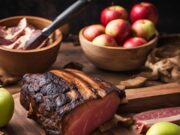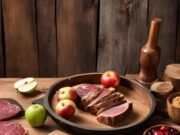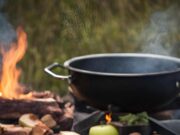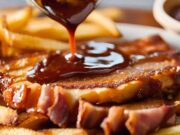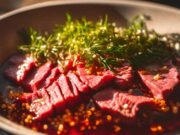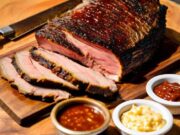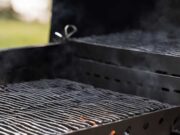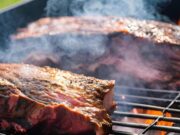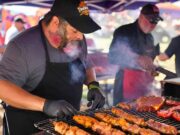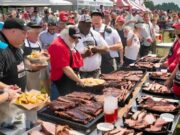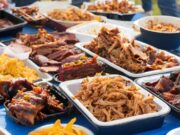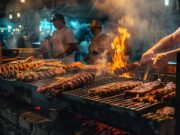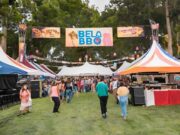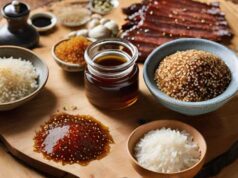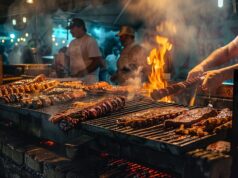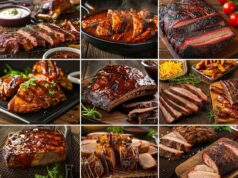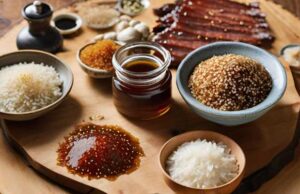Barbecue in the Colonial Era: Traditions and Techniques
Embark on a savory journey back to the 17th century, where the foundations of what we know as Southern barbecue were being laid. Fueled by a delectable blend of Native American, European, and African culinary influences, the art of barbecuing carved its niche within the American culinary staple. The humble barbecue – a term borrowed from the Taino Indian word “barbacoa” – was not just a method of cooking meats over wooden frames, but a tool for social and political engagement. And at the heart of it all were African American cooks, whose mastery in infusing flavors and techniques from the West and Central Africa, gave us the rich, diverse tradition of barbecue we relish today. Dive into the intricacies of colonial southern barbecue and discover the evolution of this American regional barbecue tradition.
Key Takeaways
- Southern barbecue, dating back to the 17th century, is a fusion of Native American, European, and African culinary traditions.
- The term “barbecue” originates from the Taino Indian word “barbacoa,” meaning a wooden grill structure over an open fire.
- Barbecuing in the early colonial era was not merely a cooking method, but also a social and political tool to foster connections and reward enslaved people.
- African American cooks, often enslaved, played a fundamental role in shaping the flavors and techniques of Southern barbecue, drawing on West and Central African culinary practices.
- Five key techniques define early American barbecues, including the use of wooden sapling grills, smoking with hickory and oak, the application of pepper vinegar and sauces, slow cooking, and the integration of various cultural influences.
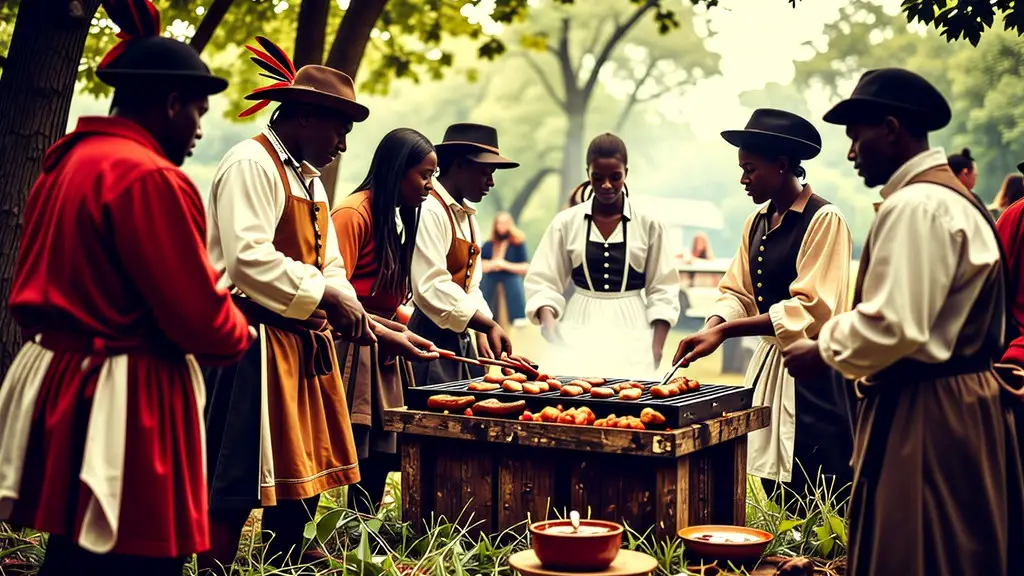
The Evolution of Southern Barbecue from the 17th Century
Shedding light on the historical transition of Southern barbecue, it’s fascinating to explore how it has morphed since the 17th century. Rooted in a blend of Native American, European, and African influences, southern barbecue practices borrowed heavily from colonial era bbq traditions and techniques. It was during this period that the term “barbecue” made its way into the American vocabulary, borrowing from the Taino Indian word “barbacoa,” which described a wooden grill structure used for cooking over an open fire.
In the early colonies, like Virginia, the process of barbecuing revolved around cooking meats, particularly pigs, over wooden frames constructed from saplings. This was a technique inspired by both indigenous Virginians and the West Indies. The act of barbecuing was not just about food, but also served as a social and political instrument, used to establish bonds among planters and their families, and as a means to reward enslaved people.
The contribution of African American cooks, many of whom were enslaved, was crucial in shaping the techniques and flavors that define Southern barbecue today. They brought elements from West and Central African culinary traditions, such as the use of peppery sauces and slow-cooking methods, enriching the taste and texture of the dishes.
To better understand the evolution of barbecue during the colonial era, let’s delve into five significant techniques that were commonly used:
- Sapling Grills: The meat was cooked on makeshift grills made from green branches of saplings like poplar and pawpaw, which were soaked to ensure they lasted through the long cooking process.
- Hickory and Oak Smoking: Early barbecuers used hickory and oak logs to flavor their meat. These logs would be burned down to hot coals, and additional soaked wood chunks were added to produce steam and smoke.
- Pepper Vinegar and Sauces: As early as the 18th century, the use of pepper vinegar for seasoning meats was documented. African influences brought in the use of spicy rubs and sauces, which were applied during the cooking process.
- Slow Cooking: Ensuring thorough cooking, meats were often cooked for several hours. Techniques included slow roasting over indirect heat and occasionally parboiling to tenderize the meat, especially for older or tougher cuts.
- Integration of Cultures: The techniques used for barbecuing combined elements from various cultures. Indigenous, African, and European methods were blended, leading to unique regional variations, such as Kentucky lamb barbecues and the pepper/vinegar-based barbecues of the Southeastern U.S.
In the colonial era, barbecue was more than just a culinary practice; it served as a melting pot of cultures and traditions. The integration of Native American, European, and African influences led to the rich and diverse barbecue tradition we see today, which has become a cornerstone of Southern cuisine. This evolution of barbecue is a testament to the diversity and adaptability of culinary practices, shaped and influenced by centuries of cultural exchange.
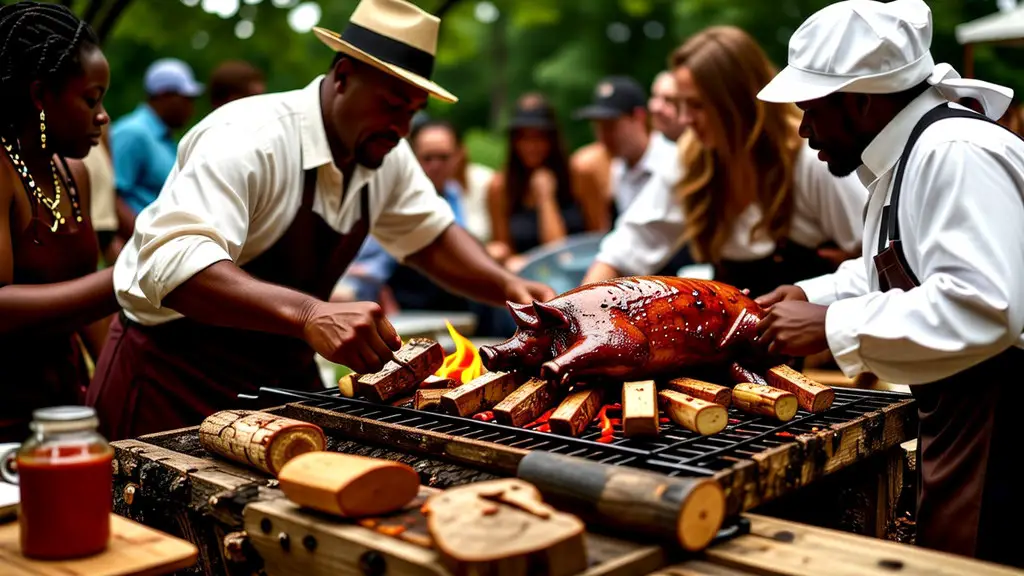
5 Key Techniques in Early American Barbecues
Delving into the Colonial Era bbq traditions and techniques, we find five pivotal components that have shaped this American culinary phenomenon.
- The Use of Green Sapling Grills: The original grill masters of early American barbecues would construct makeshift grills from green sapling branches, often from poplar or pawpaw trees. These branches were soaked in water to withstand the long hours of slow cooking.
- Infusing Flavor with Hickory and Oak: Back in the day, hickory and oak logs were the preferred choice for creating a hearty, smoky flavor. Burned down to hot coals, these logs served as the heat source, while additional soaked wood chunks were added to generate smoke and steam, further enhancing the flavor profile of the meat.
- Pepper Vinegar and Other Spicy Accents: In keeping with traditions dating back to the 18th century, pepper vinegar was a popular choice for seasoning meats. African influences introduced the use of spicy rubs and sauces, which were applied during the cooking process to add a kick of flavor.
- Embracing the Slow Cook: True to the ethos of barbecue, meats were cooked slowly over several hours. This process involved slow roasting the meat over indirect heat, and occasionally, the meat was parboiled to ensure a tender result, particularly for older or tougher cuts.
- Melding of Multicultural Influences: Early American barbecue was a melting pot of various cultural techniques. The amalgamation of Indigenous, African, and European methods resulted in unique regional variations, such as the pepper and vinegar-based barbecues of the Southeastern U.S., and the lamb barbecues of Kentucky.
Through the lens of these five key components, we can see the journey of barbecue from a rudimentary cooking technique in the Colonial Era to an iconic symbol of Southern cuisine. The evolution of barbecue is a testament to the confluence of diverse cultures and their culinary practices. Each technique lending its unique touch to what has become a beloved tradition, and a pillar of culinary heritage not just in the South, but across the United States.

Conclusion
The colonial era barbecue is an intricate tapestry woven with culinary threads from indigenous, African, and European cultures. It was a unique alchemy of traditions and techniques that has greatly influenced the Southern barbecue we relish today. Through the use of wooden sapling grills, the art of smoking with hickory and oak, the spicy tang of pepper vinegar and sauces, and the patient method of long, slow cooking, early American barbecues carved out a distinct flavor profile that continues to tantalize taste buds centuries later.
Much like a time-honored recipe, the evolution of Southern barbecue carries the essence of its historical beginnings and the fingerprints of the cultures that nurtured it. This communal cooking tradition served not just as a means of sustenance, but also as a social and political tool, fostering bonds and connections. As we savor our modern barbecues, let us appreciate this rich history and the cultural blend that has shaped our beloved Southern barbecue. The story of barbecue is, after all, a story of America itself – a melting pot of flavors, traditions, and people.
FAQ
- What are the origins of southern barbecue? Southern barbecue is a culinary tradition that can be traced back to the 17th century. It blends Native American, European, and African influences. The term “barbecue” itself comes from the Taino Indian word “barbacoa,” which refers to a wooden grill structure used for cooking over an open fire.
- How did barbecue evolve in the colonial era? During the colonial era, barbecuing became a social and political tool used to foster connections among planters, their families, and to reward enslaved people. African American cooks, often enslaved, were pivotal in developing the techniques and flavors that define Southern barbecue, incorporating elements from West and Central African culinary traditions, such as the use of peppery sauces and slow-cooking methods.
- What were some key techniques in early American barbecues? Key techniques included cooking meats on makeshift grills made from green branches of saplings, smoking with hickory and oak logs, seasoning meats with pepper vinegar and sauces, and slow cooking over indirect heat for several hours. These techniques combined elements from various cultures leading to unique regional variations.
- What were some of the cultural influences in early American barbecues? Barbecuing techniques combined elements from Indigenous, African, and European methods. This led to unique regional variations, such as Kentucky lamb barbecues and the pepper/vinegar-based barbecues of the Southeastern U.S.
- More than a culinary practice, what was the significance of barbecue in the colonial era? Barbecue in the colonial era was a confluence of cultures and traditions, evolving through the contributions of Native Americans, Europeans, and Africans. It was a means of fostering social connections and was also a political tool. The result was a rich, diverse barbecue tradition that has become a cornerstone of Southern cuisine.



